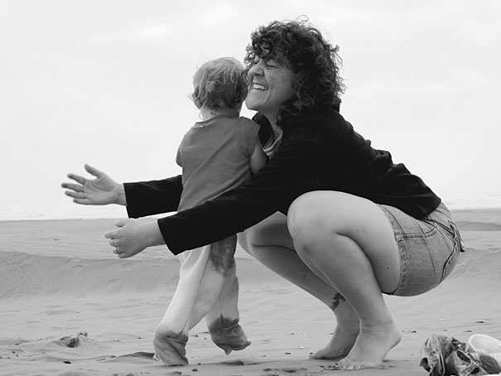The No Cry Discipline Solution (57 page)
Read The No Cry Discipline Solution Online
Authors: Elizabeth Pantley

rant is not the place to battle over new and unfamiliar foods.
• Don’t stay if you’re not having fun.
If a child’s behavior
gets out of hand, take her to the restroom or out to the car for a
time-out. If she continues to misbehave, don’t be afraid to ask for
doggie bags and leave the restaurant. But don’t give up. Review
your expectations and try again.


See also: Sibling Fights; Yelling, Screaming,
and Shouting
When my children play they like to wrestle, chase, and
shout. They’re noisy and rambunctious. I don’t have
a lot of patience for this, so I usually end up yelling at
them to stop.
Think About It
Children have an abundance of energy—and it’s a good thing. We
just need to help them fi nd the right outlets for that energy.
What to Do
• Move them to another place.
If the problem is the
location
of the play more than the play itself, just shift the setting. When you
see the children begin to get physically active, move them outside
or to a room that is safe for rough-and-tumble activity.
• Stop the play before it gets out of hand.
Perhaps you repeat-
edly admonish your children to “be careful” or “settle down” but
let things progress until something is broken or someone is hurt.
Only then do you actually put a stop to the action. Instead, step
in when you sense that things are headed in the wrong direction
and divert their attention to a different activity.
252
Copyright © 2007 by Better Beginnings, Inc. Click here for terms of use.
Roughhousing or Wild Play
253
• Provide optional entertainment.
Sometimes children start
roughhousing if they are bored and not being creative about fi nd-
ing something to do. Put together an easily accessible “activity
closet” with games, crafts, puzzles, art supplies, and other activities
that can help to absorb their energies.
What Not to Do
• Don’t yell.
Adding your loud voice to an already intense
situation won’t help your children calm down or fi nd something
productive to do.
• Don’t threaten.
Don’t make empty threats like “If you don’t
stop right now, then I’ll. . . .” These statements undermine your
authority and assume disobedience. Moreover, these threats usu-
ally aren’t carried out and your children know that, so they don’t
encourage the cooperation you’re hoping for. The only thing
threats tend to do is create negative energy. Try to stick to instruc-
tions that tell your children what you
do
want them to do.


See also: Biting Other Children; Hitting, Kicking,
and Hair Pulling; Sibling Fights
My child has a hard time sharing her toys
with others.
Think About It
Sharing is a complicated social skill that takes guidance and prac-
tice to develop. Young children get very attached to their posses-
sions, and they don’t understand how sharing will affect them or
their toy. In order to get a better understanding of these feelings,
think for a minute about one of your most prized or important
possessions—perhaps your computer, camera, car, or boat. Now
think of having a friend take it away to use for a day. That feeling
of apprehension and uncertainty, plus inexperience, may be at the
root of your child’s reluctance to share.
What to Do
• Demonstrate how to share.
Share things with your child
and point out that you are sharing. For example, “Would you like
a turn on my calculator? I’d be happy to share it with you.”
• Encourage your child to share toys with you.
It’s often
easier for a child to share with a parent, since the child knows
you’ll be careful and that you’ll give the toy back when you’re done.
254
Copyright © 2007 by Better Beginnings, Inc. Click here for terms of use.

Sharing
255
It makes for good sharing practice. When you hand her toy back,
explain what she just did. “You shared so nicely, thank you.” That
way she has a good feeling about what it means to share, since her
young friends probably won’t treat it the same way.
• Give your child choices.
Instead of demanding that your
child share a specifi c toy, give her some options. “Sarah would like
to play with a stuffed animal. Which one would you like to let her
play with?”
• Create situations that require sharing.
Your child can get
good practice with sharing when given toys or games that require
two or more people to play, such as board games or yard games
(such as badminton). Also look for activities that have plenty of
opportunities for everyone to participate, such as modeling clay,
coloring or art projects, or building blocks.
Arianna, age 2, and Mommy





